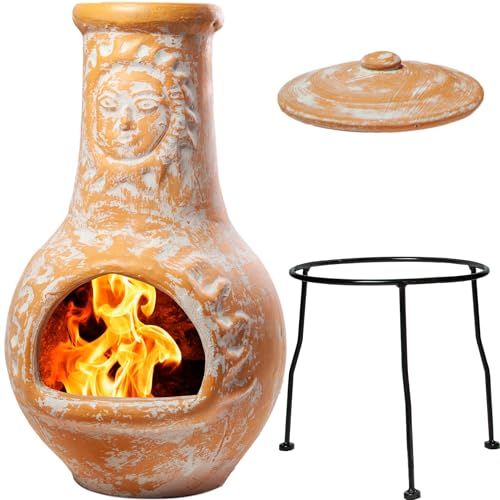What's The Job Market For Ceramic Chiminea Professionals?
페이지 정보

본문
The Basics of a Ceramic Chiminea
 Clay is the most commonly used material used to make chimineas. Think of terracotta ware or red pottery. Clay is extremely strong and hard but can crack when handled improperly.
Clay is the most commonly used material used to make chimineas. Think of terracotta ware or red pottery. Clay is extremely strong and hard but can crack when handled improperly.
Clay is highly absorbent, and therefore needs to be protected by sand or gravel at the bottom of a chiminea along with logs or kindling. This prevents the clay from burning too hot and seals hairline cracks.
Materials
The chimineas made of clay (also called pot-bellied ovens) include a chimney that sends smoke upwards. Chimineas of this type have glazes to guard them against weathering and cracking caused by sudden temperature fluctuations. However, they are still vulnerable to sun and rain. It is therefore important to cover them when not in use, and to prevent water puddles from forming inside the clay.
The majority of chimineas clay are constructed from terracotta, however other materials like cast iron and steel are also available. Terracotta offers the classic Mexican look as well as aluminum and cast iron are durable alternatives that require less care than terracotta. Some manufacturers also offer modern designs that blend the beauty of a chiminea made of clay with the strength of metal.
Many people choose to pair their chimineas with flowering or evergreen plants. This creates a natural look to add a natural feel to their backyard. It is essential to select plants that go together it is essential for a chiminea to be placed in an area that is free of overhead structures that could catch fire. It is also essential to make sure that the chiminea is placed on a safe surface like concrete, brick or stone patios.
Chiminesas can be created by hand using high-fired unglazed clay. The person who creates the clay is referred to as a potter, and they can throw the piece on a potter's wheel or using a mould made of plaster. In either case, the clay is kneaded prior allowed to dry. Certain newer clay chimineas are pre-grogged, which is an additive that can help them resist thermal stresses that are prone to cracking traditional earthenware.
Other chimineas can be made in metal molds, which give them different designs and shapes that can be adapted to any backyard. Cast iron chimineas may be heavier than clay models but they are more robust and less likely to break or crack due to sudden temperature fluctuations. They are cheaper than other types of chimineas, too and are available in gas-burning models as well to give you more versatility.
Styles
Chimines are designed to resemble an outdoor fireplace and can be decorated with various materials and styles. Terracotta chimineas have a traditional look that dates back to the past, while metal alternatives are more durable and can handle high temperatures. Many chimineas have designs and patterns that match the furniture of the patio. A rustic finish, for instance can give your chiminea an old-fashioned look, especially if you pair it with wood or iron patio furniture.
Chimineas are usually designed to be freestanding, but they can also be erected on a brick, stone, or concrete patio. Whatever you decide to put your chiminea, pick a spot that is protected from wind and is away from flammable plants or structures. It is crucial to keep in mind that chimineas emit soot and smoke that could affect the air quality in the area.
Some chimineas have a chimney that opens at the lower part of the structure, while others are squat and point upwards. Both styles include or lack an opening large enough to add firewood. The chimneys on squat models are designed to be formed to create a more dramatic appearance and also add visual appeal.
You can also add decorative elements on the outside of your Chiminea, such as wrought iron, marble, or granite. You can also consider a ceramic or copper top to add a bit of style. The glossy shimmer of these finishes can help to reflect light from your chiminea and improves the overall appearance of your chiminea.
Regular chiminea polishing is a good option to enhance the appearance of your fire pit outside and shield it from damage. Use beeswax, olive oil or other natural products to polish the surface for an ethereal, glowing appearance. Apply a thin coat and gently rub before rinsing and drying the chiminea terracotta for a radiant result.
Chimineas need a lot of maintenance, but with proper care and attention, your unique outdoor chiminea can remain stylish for years to come. With the help of practical decorating strategies and maintaining your chiminea's condition, you'll be able to enjoy it throughout the cooler seasons.
Safety
Although chimineas are popular but they can be dangers to safety if they are not properly utilized. Chimineas made of clay are susceptible to cracking, particularly those that aren't glazed. They also pose a fire hazard when placed too close to other flammable materials, including your home, outdoor furniture and the surrounding garden. You should only use a chiminea outdoors and in an area that is secured or surrounded by fire-safe materials.
Keep a fire extinguisher near you and make use of it to extinguish small fires or hot coals which may happen when you are tending to your flame. You can also make use of a long lighter for lighting your fire, and move the coals with tongs instead of your hands. A bucket of water is also an excellent thing to keep close by in the event that the chiminea has to be snuffed out. It is crucial to never use water to extinguish a chiminea that has been chilled down and to only add water after the fire has died naturally or when a large chiminea fire is in danger of bursting the chimney.
The draft generated by a chiminea may send sparks upwards through the stack, and it is crucial to safeguard your property and your neighbors from burns that could happen accidentally by using simple spark arrestors constructed from chicken wire placed around the top of the smokestack. Chimineas can also become extremely hot, and the area around them. You should put up a low wall to warn people against getting too close to.
Do not burn your chiminea in stormy or rainy weather. The sparks can cause the chimney to catch fire, which could cause damage to your home. Make sure to inquire with your local fire department to see if there burn restrictions in place prior to using a Chiminea. Before adding firewood to the chiminea, you should clean the area around it. This will ensure that there aren't any flammable materials within the area. It is also an excellent idea to clean the interior of your chiminea following each use to prevent ash buildup that can result in smoke inhalation as well as a sooty exterior.
Maintenance
Clay chimineas require some maintenance even although they can be used to make outdoor fires. To ensure their longevity, they must be treated the same as all clay products. This means avoiding allowing them to become too hot too quickly and making sure to allow them to cool between each use. They must also be sanded frequently and sealed to keep the paint from being damaged.
It is crucial to clear the ashes after each use of your chiminea but only when it has completely cool. It will remain warm, even though it appears to have cooled down, so make use of a small rake and a brush to clear away the ash. After you have carefully removed the ash and cleared away the debris the next step will be to fill the bottom of the chiminea either gravel or sand. If you don't fill it your chiminea might crack. The clay absorbs moisture, and could crack if it is too dry.
Some sources suggest sealing the exterior of the chiminea with an acrylic waterproofing agent similar to the ones used to seal tiles. This will stop moisture from damaging the chiminea. It is recommended that the chiminea terracotta is cleaned and resealed every 6 to 8 weeks during periods of heavy use.
Chimineas should only be burned on bare, fire-safe surfaces. They should not be used on decking made of wood or on any other type of overhead covering. Only using hardwood that has been well-seasoned will reduce the number of sparks and prevent the clay from cracking.
A chiminea for sale that is made of clay won't last for long. However it is extremely not likely to break unless you drop it or beat it with the force of a Hammer. Cracks can occur due to a variety of reasons, such as poor combustion and lack of maintenance. They are also susceptible to rust and need to be kept covered, at least when not in use. This will keep the snow and rain off of it, ensuring that it will not begin to corrode the metal components of the chiminea.
 Clay is the most commonly used material used to make chimineas. Think of terracotta ware or red pottery. Clay is extremely strong and hard but can crack when handled improperly.
Clay is the most commonly used material used to make chimineas. Think of terracotta ware or red pottery. Clay is extremely strong and hard but can crack when handled improperly.Clay is highly absorbent, and therefore needs to be protected by sand or gravel at the bottom of a chiminea along with logs or kindling. This prevents the clay from burning too hot and seals hairline cracks.
Materials
The chimineas made of clay (also called pot-bellied ovens) include a chimney that sends smoke upwards. Chimineas of this type have glazes to guard them against weathering and cracking caused by sudden temperature fluctuations. However, they are still vulnerable to sun and rain. It is therefore important to cover them when not in use, and to prevent water puddles from forming inside the clay.
The majority of chimineas clay are constructed from terracotta, however other materials like cast iron and steel are also available. Terracotta offers the classic Mexican look as well as aluminum and cast iron are durable alternatives that require less care than terracotta. Some manufacturers also offer modern designs that blend the beauty of a chiminea made of clay with the strength of metal.
Many people choose to pair their chimineas with flowering or evergreen plants. This creates a natural look to add a natural feel to their backyard. It is essential to select plants that go together it is essential for a chiminea to be placed in an area that is free of overhead structures that could catch fire. It is also essential to make sure that the chiminea is placed on a safe surface like concrete, brick or stone patios.
Chiminesas can be created by hand using high-fired unglazed clay. The person who creates the clay is referred to as a potter, and they can throw the piece on a potter's wheel or using a mould made of plaster. In either case, the clay is kneaded prior allowed to dry. Certain newer clay chimineas are pre-grogged, which is an additive that can help them resist thermal stresses that are prone to cracking traditional earthenware.
Other chimineas can be made in metal molds, which give them different designs and shapes that can be adapted to any backyard. Cast iron chimineas may be heavier than clay models but they are more robust and less likely to break or crack due to sudden temperature fluctuations. They are cheaper than other types of chimineas, too and are available in gas-burning models as well to give you more versatility.
Styles
Chimines are designed to resemble an outdoor fireplace and can be decorated with various materials and styles. Terracotta chimineas have a traditional look that dates back to the past, while metal alternatives are more durable and can handle high temperatures. Many chimineas have designs and patterns that match the furniture of the patio. A rustic finish, for instance can give your chiminea an old-fashioned look, especially if you pair it with wood or iron patio furniture.
Chimineas are usually designed to be freestanding, but they can also be erected on a brick, stone, or concrete patio. Whatever you decide to put your chiminea, pick a spot that is protected from wind and is away from flammable plants or structures. It is crucial to keep in mind that chimineas emit soot and smoke that could affect the air quality in the area.
Some chimineas have a chimney that opens at the lower part of the structure, while others are squat and point upwards. Both styles include or lack an opening large enough to add firewood. The chimneys on squat models are designed to be formed to create a more dramatic appearance and also add visual appeal.
You can also add decorative elements on the outside of your Chiminea, such as wrought iron, marble, or granite. You can also consider a ceramic or copper top to add a bit of style. The glossy shimmer of these finishes can help to reflect light from your chiminea and improves the overall appearance of your chiminea.
Regular chiminea polishing is a good option to enhance the appearance of your fire pit outside and shield it from damage. Use beeswax, olive oil or other natural products to polish the surface for an ethereal, glowing appearance. Apply a thin coat and gently rub before rinsing and drying the chiminea terracotta for a radiant result.
Chimineas need a lot of maintenance, but with proper care and attention, your unique outdoor chiminea can remain stylish for years to come. With the help of practical decorating strategies and maintaining your chiminea's condition, you'll be able to enjoy it throughout the cooler seasons.
Safety
Although chimineas are popular but they can be dangers to safety if they are not properly utilized. Chimineas made of clay are susceptible to cracking, particularly those that aren't glazed. They also pose a fire hazard when placed too close to other flammable materials, including your home, outdoor furniture and the surrounding garden. You should only use a chiminea outdoors and in an area that is secured or surrounded by fire-safe materials.
Keep a fire extinguisher near you and make use of it to extinguish small fires or hot coals which may happen when you are tending to your flame. You can also make use of a long lighter for lighting your fire, and move the coals with tongs instead of your hands. A bucket of water is also an excellent thing to keep close by in the event that the chiminea has to be snuffed out. It is crucial to never use water to extinguish a chiminea that has been chilled down and to only add water after the fire has died naturally or when a large chiminea fire is in danger of bursting the chimney.
The draft generated by a chiminea may send sparks upwards through the stack, and it is crucial to safeguard your property and your neighbors from burns that could happen accidentally by using simple spark arrestors constructed from chicken wire placed around the top of the smokestack. Chimineas can also become extremely hot, and the area around them. You should put up a low wall to warn people against getting too close to.
Do not burn your chiminea in stormy or rainy weather. The sparks can cause the chimney to catch fire, which could cause damage to your home. Make sure to inquire with your local fire department to see if there burn restrictions in place prior to using a Chiminea. Before adding firewood to the chiminea, you should clean the area around it. This will ensure that there aren't any flammable materials within the area. It is also an excellent idea to clean the interior of your chiminea following each use to prevent ash buildup that can result in smoke inhalation as well as a sooty exterior.
Maintenance
Clay chimineas require some maintenance even although they can be used to make outdoor fires. To ensure their longevity, they must be treated the same as all clay products. This means avoiding allowing them to become too hot too quickly and making sure to allow them to cool between each use. They must also be sanded frequently and sealed to keep the paint from being damaged.
It is crucial to clear the ashes after each use of your chiminea but only when it has completely cool. It will remain warm, even though it appears to have cooled down, so make use of a small rake and a brush to clear away the ash. After you have carefully removed the ash and cleared away the debris the next step will be to fill the bottom of the chiminea either gravel or sand. If you don't fill it your chiminea might crack. The clay absorbs moisture, and could crack if it is too dry.
Some sources suggest sealing the exterior of the chiminea with an acrylic waterproofing agent similar to the ones used to seal tiles. This will stop moisture from damaging the chiminea. It is recommended that the chiminea terracotta is cleaned and resealed every 6 to 8 weeks during periods of heavy use.
Chimineas should only be burned on bare, fire-safe surfaces. They should not be used on decking made of wood or on any other type of overhead covering. Only using hardwood that has been well-seasoned will reduce the number of sparks and prevent the clay from cracking.
A chiminea for sale that is made of clay won't last for long. However it is extremely not likely to break unless you drop it or beat it with the force of a Hammer. Cracks can occur due to a variety of reasons, such as poor combustion and lack of maintenance. They are also susceptible to rust and need to be kept covered, at least when not in use. This will keep the snow and rain off of it, ensuring that it will not begin to corrode the metal components of the chiminea.

- 이전글15 Best Documentaries About Patio Doors Aylesbury 24.09.27
- 다음글9 Things Your Parents Taught You About Chiminea Terracotta 24.09.27
댓글목록
등록된 댓글이 없습니다.





 스포츠토토 유용한 정보
스포츠토토 유용한 정보  가상경기 배팅게임
가상경기 배팅게임 